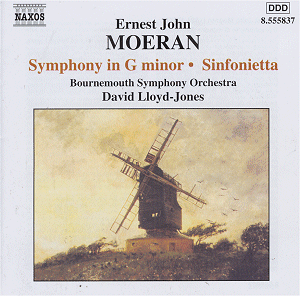Commissioned in 1924 by Hamilton Harty Moeran’s Symphony in
G underwent many of the vicissitudes that visited the composer during
the completion of larger scale orchestral music, of which this work and
the absurd muddle over the first performance and dedication of the Violin
Concerto are probably the peaks. The thirteen year wait though was well
worth it even though it seems Moeran shelved much of what he wrote immediately
following the commission and began work on the symphony in earnest again
only around 1934.
I believe we owe this recording to some spare studio
time – if that’s indeed the case then the Bournemouth orchestra are
as flexible and idiomatic as the conductor, David Lloyd-Jones, has increasingly
proved himself to be in the British repertoire. And they have together
given us an excellent recording, thoroughly recommendable, with one
stringent caveat, even though it doesn’t for me efface memories of Boult,
Handley and Dilkes – or Heward. There is a beautiful reserve of delicacy
for the famous second subject of the first movement and I particularly
admired the handling of the burnished yet unsettled writing from 6.35.
Strings are ecstatic – though not uncontrolled – at 3.50 in the Lento
with brass interjections subtly moulded and the culminatory writing
at 5.40 – swirling strings – is excellently handled. The Sibelian inheritance
of the work has long been noted but it’s still fascinating to hear the
Nordic rhythmic insistence of the incident beginning at 7.40 – well
integrated by Lloyd-Jones as well. Delicacy and grace are well subsumed
in the elfin scherzo, albeit with its contrastive eruptive material
on show. It was only in the finale that doubts crept in. I admire the
horn and string Sibelian surge, even the beautifully modulated explicitly
Elgarian passage beginning at 5’40 (Elgar 2, the Elgar and Sibelius
derivations are by now tedious to point out but unmistakeable). But
the finale’s close is the real problem. There is something relatively
slack about it that disappoints. Comparison with, say, Heward, the most
visceral of all recordings of the Symphony, its premiere recording from
1942, shows a greater weight of anticipation and tension, a stronger,
semi dormant bass line, malign and omnipresent, that Lloyd-Jones can’t
begin to match. Heward’s overlapping melodic impress lent a sense of
overwhelming conclusiveness – albeit an ambiguous one – to the finale,
the final eruption a culmination of the earlier orchestral prophecies.
In comparison Lloyd Jones is hardly supine but he is unpreparedly abrupt.
So a good performance then, let down for me by the finale. The Royal
Philharmonic Society premiere of the Symphony at Queen’s Hall, conducted
by Heward, in January 1938 does apparently exist. It would be fascinating
to hear this document and to contrast it with the recording he made
four years later.
The Sinfonietta is unalloyed delight. Beautiful string
figuration and horn and clarinet writing animate the first movement
– and there are some intoxicating Moeran moments of sweeping grandeur.
The baroque-folk hints of the Tema second movement unleash some rushing
strings and powerful trumpet (notably well-balanced by the engineers)
with a fugal episode as strong as it is short. The delicacy and expressive
simplicity of the Fourth Variation is tenderly done, cellos coursing
through the line, exceptionally expressive on the E string. And how
well those little hesitant displacements of the Sixth variation are
conveyed before the drama and delight of the concluding Allegro risoluto.
Notes are by Lewis Foreman and up to his high standard,
engineering and production values are high as well; I admired much of
the conception and execution here and as such this is a real bargain
disc even if, for the deeper complexities of the Symphony, you will
need to look elsewhere.
Jonathan Woolf
Also see review
by Neil Horner


